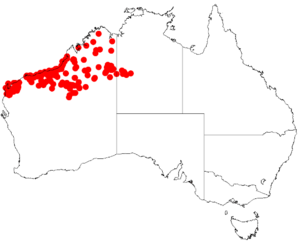Northern star wattle facts for kids
Quick facts for kids Northern star wattle |
|
|---|---|
| Scientific classification | |
| Genus: |
Acacia
|
| Species: |
stellaticeps
|
 |
|
| Occurrence data from AVH | |
The Northern star wattle (Acacia stellaticeps) is a cool shrub found in parts of Australia. People also call it the poverty bush or glistening wattle. Indigenous Australians have their own names for it too. The Nyangumarta people call it pirrnyur or pirrinyurru, and the Ngarla people know it as panmangu. It's part of a big group of plants called Acacia, which are known for their beautiful flowers.
What Does the Northern Star Wattle Look Like?
This plant is a low, dense shrub. It usually grows up to 2 metres (about 6.5 feet) tall. It can also spread out to about 3 metres (almost 10 feet) wide. It has many thin main stems that grow from the ground. These stems have smooth or slightly cracked grey bark.
Like most Acacia plants, it doesn't have true leaves. Instead, it has special leaf-like parts called phyllodes. These phyllodes are a dull green to grey-green colour. They are shaped a bit like an oval, but not perfectly even. They are usually 5 to 25 millimetres long (about 0.2 to 1 inch). They are also 3 to 15 millimetres wide (about 0.1 to 0.6 inches). You might see one to three faint lines, or nerves, running along them. The Northern star wattle blooms from October to May. During this time, it produces bright yellow flowers.
Where Does the Northern Star Wattle Grow?
The Northern star wattle is native to Australia. You can find it in the Kimberley, Pilbara, and northern Goldfields areas of Western Australia. It also grows eastward into the Great Sandy Desert and the Tanami Desert in the Northern Territory.
This shrub likes to grow on flat areas, plains, and sand ridges. It prefers stony, sandy, or clay soils. You'll often see it in areas with soft spinifex grasses. It especially likes to grow with Triodia pungens and Triodia epactia. In red sandy soils, the Northern star wattle can form large, thick patches all by itself.

